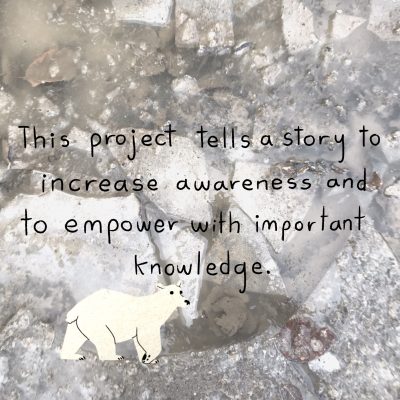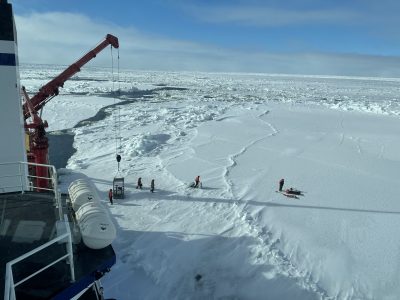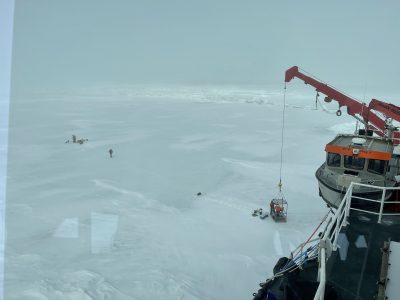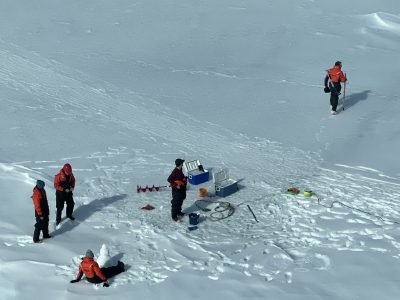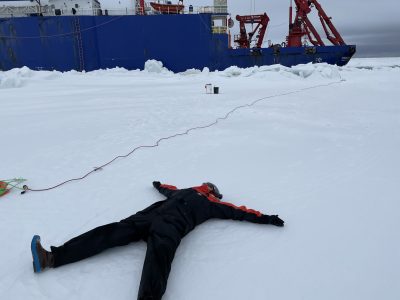Arctic Marginal Ice Zone Alkalinity (AMIZA)

This exciting project funded by NSF Arctic Sciences award 2049991 “Carbonate system dynamics and biogeochemistry in a changing Arctic”.
Publications:
- Vlahos, P., Lee, K., Lee, CH. et al. Non-conservative nature of boron in Arctic marginal ice zones. Commun Earth Environ 3, 214 (2022). https://doi.org/10.1038/s43247-022-00552-0
- NSF: Arctic Data Repository Boron in seawater, ice and brine in the Bering and Chukchi Seas May-June 2021. Arctic Data Center. doi:10.18739/A2V698D41.
- Barrett, L.J., Vlahos, P., Hammond, D.E., Mason,R.P. Sediment-water fluxes of inorganic carbon and nutrients in the Pacific Arctic during the sea ice melt season, Continental Shelf Research 268, 105116 https://doi.org/10.1016/j.csr.2023.105116
Presentations:
- Non-conservative nature of Boron in low salinity Arctic ice and ice melt zones S Rush, CH Lee, K Lee, P Vlahos, L Barrett EGU24 (Vienna, Austria)
- Introduction:
Arctic Ocean summer sea ice is predicted to retreat such that in just a few decades the new norm will be ice-free summers. We collected water samples on the RV Sikuliaq between May 20 to June 14, 2021, from the Bering sea to the marginal ice zone in the Chukchi Sea. The area where open water becomes progressively more ice-covered (and ice melt is a significant signal), presents a unique opportunity to better understand the complexities in arctic biogeochemistry and its changing role in carbon sequestration as the summer ice edge recedes. By examining the internal consistency of the carbonate system/models, the work will lead to an improved understanding of the controls on ocean acidification and ocean-atmosphere CO2 exchange. We examine important carbonate system measurements such as dissolved organic and inorganic carbon, that when coupled with parallel mercury measurements taken concurrently on the Sikuliaq, will improve our understanding of the relationships between dissolved elemental Hg and DIC in the Arctic, both in the open water and under the ice. We are generating hands-on videos and materials for citizen science groups with a focus on polar regions. Finally, look out for a cruise podcast series that will comprise five to ten minute podcasts for the public on the changing arctic, what it’s like to be a young oceanographer, and themes related to the study.
This clip illustrates the cruise track and the position of the marginal ice zone over the entire study period – skq202108s_icestations.
Here is a great animation of the minimum and maximum sea ice extent in the Arctic since 1999.
Our Stories:
On May 4th we arrived in Dutch Harbor, Alaska at the tip of the Aleutian islands for a 2-week pre-cruise COVID isolation. Isolation requirements were just beginning to change though not fast enough to reduce ours. That said we enjoyed the raw nature of the Aleutian Islands, saw numerous bald eagles and did several of the nearby hikes while we waited.
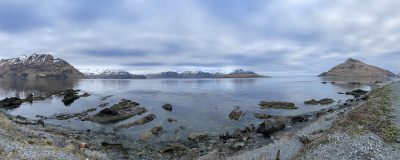
That said we enjoyed the raw nature of the Aleutian Islands, saw numerous bald eagles and did several of the nearby hikes while we waited.
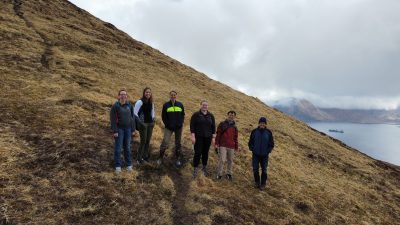
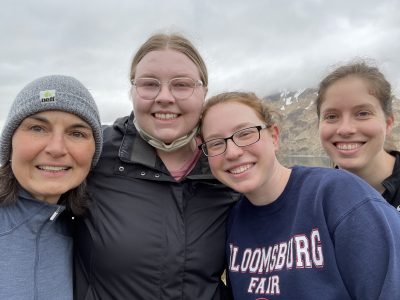
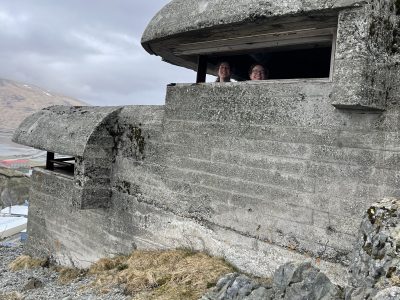
On May 19th at 8am we boarded the RV Sikuliaq and began setting up our equipment right away. By 5 pm (dinner time) all was in place and secured.
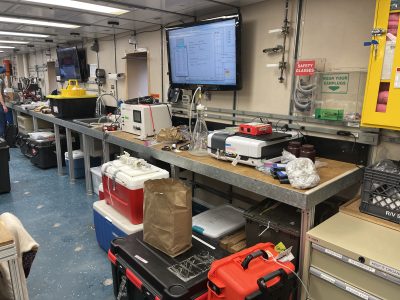 Set up of continuous alkalinity measurements using the Hydros TA aka “Atticus” and the spectrophotometric pH in the main lab.
Set up of continuous alkalinity measurements using the Hydros TA aka “Atticus” and the spectrophotometric pH in the main lab.
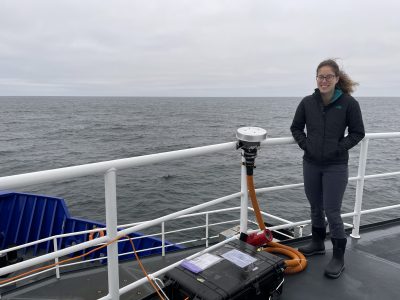
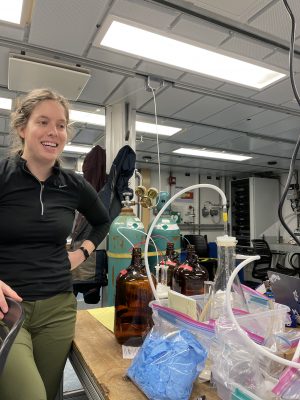 Emma Shipley and high volume air sampler (left) installed below the bridge. Large volume surface water extractions (right). Emma is investigating the air-sea flux and distributions on brominated organic molecules (bromoanisols and bromophenols) that are made naturally in seawater by algal and bacterial assemmblages in the Beafort and Chukchi Seas along with other organocompounds.
Emma Shipley and high volume air sampler (left) installed below the bridge. Large volume surface water extractions (right). Emma is investigating the air-sea flux and distributions on brominated organic molecules (bromoanisols and bromophenols) that are made naturally in seawater by algal and bacterial assemmblages in the Beafort and Chukchi Seas along with other organocompounds.
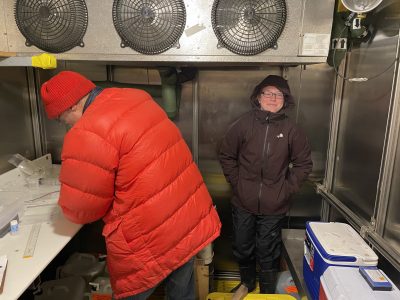 Lauren Barrett and Doug Hammond sampling sediment cores for benthic fluxes in the climate controlled chamber.
Lauren Barrett and Doug Hammond sampling sediment cores for benthic fluxes in the climate controlled chamber.
Our target was to sample intensely across the marginal ice zone to evaluate under ice water, brine and surrounding ice melt. The experience was exhilarating and polar bears kept everyone alert.
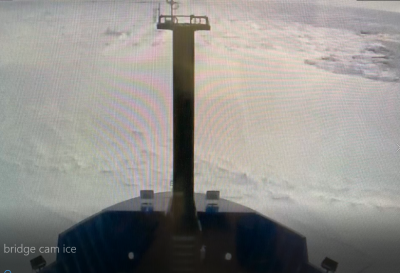
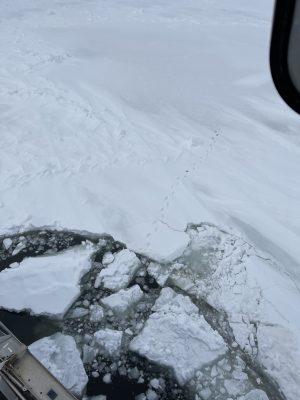

Station 5 bears
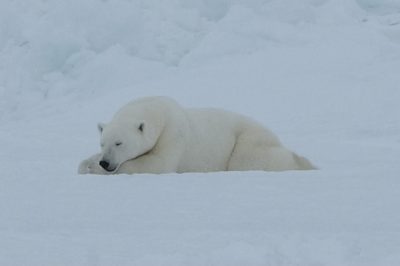
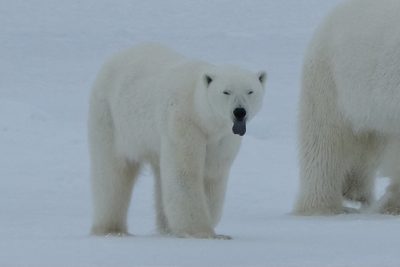
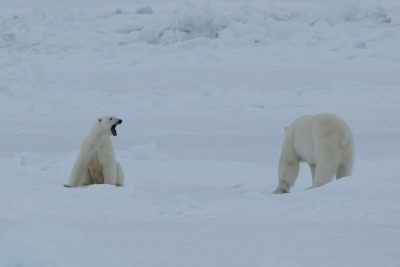
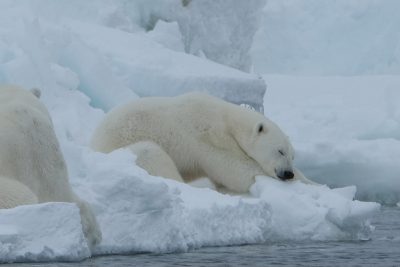
When the bears were about 2 miles away we began sampling.
Post Cruise:
We presented the first results from the cruise at the 2022 Ocean Sciences Meeting:
-
-
-
Concentrations of boron along an arctic marginal ice zone Penny Vlahos, Session Block: HL11 Arctic Ocean processes, progress, and potential explored through synthesis supported research 01, Session Format: Oral Session Date and Time: 3/3/2022: 9:00 AM – 10:00 AM
-
Detection and Quantification of Brominated Natural Products in Arctic and Mid-Latitude Coastal Air and Waters Emma Shipley, Session Block: HL11 Arctic Ocean processes, progress, and potential explored through synthesis supported research 02 Session Format: Oral Session Date and Time: 3/3/2022: 10:00 AM – 11:00 AM
-
Carbonate System Dynamics in the Chukchi Sea Summertime Marginal Ice Zone Lauren Barrett, Session Block: HL11 Arctic Ocean processes, progress, and potential explored through synthesis supported research 02 Session Format: Oral Session Date and Time: 3/3/2022: 10:00 AM – 11:00 AM
-
-
We have also Submitted our first manuscript: “A changing Arctic: Non-conservative nature of boron in marginal ice zones” to Nature Communications Earth & Environment.
Results from Broader Impacts:
Students from the University for the Creative Arts in the UK working with Prof. Iro Tsavala based their senior illustration projects on AMIZA following discussions with PI Vlahos.
These are some of the products:
“Letter to a Polar Bear” by Jamie Mabb
